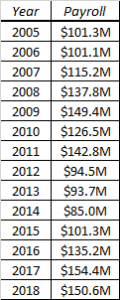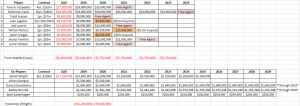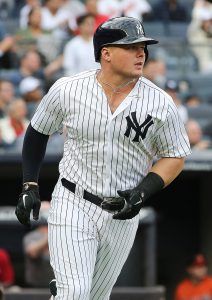Last Sunday, we took a look at the improvements (or lack thereof) the worst bullpens of the 2018 major league season have made since the winter began. Today’s edition will focus on the sorriest rotations from 2018, when the starting staffs of the Orioles, Rangers, Blue Jays, Padres and White Sox posted ERAs upward of 5.00. Those teams also fared poorly in terms of fWAR, unsurprisingly, with the Orioles, Rangers, Padres and White Sox joining the Reds to make up the majors’ bottom five in that department. Even though spring training is set to open across the league, there are still some quality starters remaining in free agency, so it’s possible these teams aren’t done yet. For now, though, most of these staffs leave much to be desired heading into the new season.
White Sox (2018 fWAR: 30th; 2018 ERA: 26th; projected 2019 rotation via Roster Resource): Last year’s White Sox received 30-plus starts from each of James Shields, Reynaldo Lopez and Lucas Giolito, but only Lopez managed adequate production. He and Giolito, two former high-end prospects, will once again take up 40 percent of Chicago’s rotation this season, while Shields is currently without a job. Carlos Rodon is also back as one of the team’s most proven starters, albeit after disappointing over 20 appearances in 2018. At least one newcomer – righty Ivan Nova, acquired from the Pirates in December – will slot in near the top of their staff, and fellow offseason pickup Manny Banuelos could join him in the starting five. The 32-year-old Nova isn’t going to wow anyone, but he’s a perfectly cromulent major league starter, having recorded ERAs in the low-4.00s and thrown 160-plus frames in each of the past three seasons. The 27-year-old Banuelos – a trade pickup from the Dodgers – is a former big-time prospect, but the lefty hasn’t appeared in the majors since 2015, when he totaled the only six starts of his career as a member of the Braves.
Given the lack of major league success Giolito, Banuelos, and depth options Dylan Covey and Carson Fulmer have experienced, the White Sox would be well served to land more rotation possibilities before the season. Their situation would look a lot better if not for the Tommy John surgery prized prospect Michael Kopech underwent last September. He’ll miss the entire season as a result, though Chicago could get its first look at its No. 2 pitching prospect, Dylan Cease, this year.
Orioles (2018 fWAR: 29th; 2018 ERA: 30th; projected 2019 rotation): Thanks in part to a less-than-stellar rotation, this is going to be the second ugly season in a row for the rebuilding Orioles. Internal improvement is possible, though, as returning starters Dylan Bundy, Alex Cobb and Andrew Cashner have all shown themselves capable of providing much better numbers than the production they registered over a combined 87 starts in 2018. Inexpensive free-agent signing Nate Karns is also a bounce-back candidate after sitting out most of 2017 and all of ’18 as he recovered from the dreaded thoracic outlet syndrome surgery. Aside from those four – any of whom could end up on the block during the season – no starting option on the Orioles’ 40-man roster has achieved success in the majors. Moreover, their farm system isn’t teeming with hurlers who are in line to make MLB impacts this season. With that in mind, rookie general manager Mike Elias may still be scouring the free-agent market for another cheap stopgap(s) after inking Karns earlier this week.
Padres (2018 fWAR: 28th; 2018 ERA: 27th; projected 2019 rotation): The Padres shrewdly signed former Angel Garrett Richards, who’s recovering from Tommy John surgery, back in November. But Richards won’t return until later in the season, if he pitches at all in 2019. Other than Richards, the Padres haven’t picked up any starters of note this winter. It hasn’t been for lack of effort, though, as they’ve been connected to the likes of Noah Syndergaard, Corey Kluber, Dallas Keuchel, Marcus Stroman and Mike Leake, among others, in the rumor mill during recent months. Syndergaard and Kluber probably aren’t going anywhere, but Keuchel remains available in free agency and both Stroman and Leake could still be trade candidates. Having failed to secure anyone from that group, the Padres continue to possess an underwhelming rotation – one that received a combined 49 starts from the now-departed duo of Clayton Richard and Tyson Ross last season. However, Chris Paddack and Logan Allen, top-100 prospects and a couple of the many prizes in a San Diego system laden with talent, may debut sometime this year.
Rangers (2018 fWAR: 27th; 2018 ERA: 29th; projected 2019 rotation): Of the seven Rangers who accrued the most starts in 2018, only one – lefty Mike Minor – remains. Fortunately for Texas, Minor was easily the best member of the club’s subpar septet. He’s now part of a completely remade starting staff which has reeled in Lance Lynn (three years, $30MM) and Shelby Miller (one year, $2MM) in free agency and Drew Smyly via trade with the Cubs. The team also has 2018 signing Edinson Volquez returning after he missed all of last season while recovering from Tommy John surgery. In all, it’s not the most compelling quintet, and it’s anyone’s guess what Miller, Smyly and Volquez will offer after their recent injury-wrecked seasons, but all five have at least shown flashes in the majors.
The soon-to-be 32-year-old Lynn has been effective and durable for most of his career; Miller’s a former star prospect who prevented runs at an excellent clip from 2014-16; Smyly generally impressed as a starter over the same three-year span as Miller; and Volquez has five seasons of 170-plus frames under his belt. Meanwhile, other than newly added minor league signing Jason Hammel, the Rangers’ depth options have virtually no major league accomplishments. A few of their top-10 prospects – Jonathan Hernandez, Taylor Hearn and Joe Palumbo – are climbing up the minor league ladder and could be in Arlington soon, however.
Reds (2018 fWAR: 26th; 2018 ERA: 25th; projected 2019 rotation): The Reds boasted a mostly healthy rotation in 2018, as six pitchers each made at least 20 starts, but no one was particularly good. Consequently, the Reds have acquired three proven MLB starters in various trades this offseason, having picked up Sonny Gray from the Yankees, Alex Wood from the Dodgers and Tanner Roark from the Nationals. There isn’t an ace among the trio, but all three are credible major league starters – which the Reds desperately needed, especially considering Matt Harvey walked in free agency. High-potential holdovers Luis Castillo and Anthony DeSclafani, who have been inconsistent in the majors, will comprise the rest of Cincinnati’s upgraded rotation to begin the season. The Reds’ new additions will push 2018 regulars Sal Romano (25 starts of 5.48 ERA/5.10 FIP ball) and Tyler Mahle (23 starts, 4.98 ERA/5.25 FIP) into depth roles, which is a plus, as is the end of the Homer Bailey era. The Reds sent Bailey and the remains of his bloated contract to the Dodgers when they traded for Wood and outfielders Yasiel Puig and Matt Kemp in a blockbuster December deal. Bailey produced catastrophic results from 2017-18, a 38-start, 197 1/3-inning span in which he mustered a 6.25 ERA.
Blue Jays (2018 fWAR: 22nd; 2018 ERA: 28th; projected 2019 rotation): The Blue Jays’ rotation handily outdid the above teams’ by fWAR last year, yet the unit still compiled the majors’ third-worst ERA. Toronto has since made modest acquisitions by trading for Richard and signing Matt Shoemaker (one year, $3.5MM). They’ll serve as placeholders for a Jays team which is at least another full year away from vying for a playoff spot, and may listen to offers for its top two starters – Stroman and Aaron Sanchez – during the upcoming season. Both Stroman and Sanchez have been outstanding at times, but that wasn’t true of either in 2018, and the two are now entering their second-last seasons of team control. Stroman and Sanchez remain atop Toronto’s rotation for the time being, with all parties hoping the righties return to their past productive and healthy ways in 2019. Beyond those two, Richard, Shoemaker and Ryan Borucki, the Blue Jays don’t possess any starters who have done much in the majors, though Sam Gaviglio (37 starts), Sean Reid-Foley (seven) and Thomas Pannone (six) have at least gained some experience.




